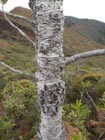Conservation Status

Araucaria rulei
F.Muell. 1860
Common names
Rule araucaria (Silba 1986).
Taxonomic notes
Araucaria section Eutacta; a molecular analysis places Araucaria rulei into the clade of large-leaved species of New Caledonia, along with A. biramulata, A. goroensis, A. humboldtensis, A. laubenfelsii, A. montana, and A. muelleri (Gaudeul et al. 2012).
Synonymy:
- Eutacta muelleri Carrière var. microphylla Carrière 1866
- Eutacta rulei (F. Muell.) Carrière 1866
- Eutacta rulei (F. Muell.) Carrière var. polymorpha Carrière 1866
- Eutacta rulei (F. Muell.) Carrière var. compacta Carrière 1867
- Araucaria rulei F. Muell. var. polymorpha (Carrière) F.M. Bailey 1914
- Araucaria rulei F. Muell. var. compacta (Carrière) F.M. Bailey 1914
- Eutassa rulei (F. Muell.) de Laub. 2009
Description
Monoecious evergreen trees to 30 m tall, with a spider-like crown. Bark dark brown, exfoliating in thin strips or scaly. Juvenile branches distichous. Adult twigs 2-2.5 cm in diameter, in long whip-like cords. Juvenile leaves narrow, scale-like, incurved, sharply acute. Adult leaves scale-like, dark green, twisted, imbricate, lanceolate, midrib prominent, apex incurved, 20-25 × 11-14 mm. Pollen cones cylindrical, 13 cm long by 30 mm wide, scales triangular, pollen sacs 15, microsporophylls triangular. Seed cones 12 × 8 cm; bracts erect, triangular, to 15 mm long with a wide base. Seeds to 3 cm long, nut with an elongated tip, wings ovate. Germination epigeal" (Silba 1986). See García Esteban et al. (2004) for a detailed characterization of the wood anatomy.
Distribution and Ecology
New Caledonia: C and S areas (de Laubenfels 1972). On New Caledonia it occur on serpentines up to an altitude of about 1,000 m, where it grows in woodlands and open country on "the most arid sites and in situations exposed to the full force of every wind, inclusive of the periodical cyclone (Compton 1920-1922)."
This map shows herbarium records of Araucaria species native to New Caledonia. Letter corresponds to first letter of species epithet with different colors for species having same first letter (A. goroensis coded as A. muelleri, see A. goroensis for discussion). Click on an icon for further information. Distribution data from GBIF (2020.03.30), edited to remove duplicates.
The IUCN reports that this species is facing a very high risk of extinction in the wild due to a limited and severely fragmented range that is suffering ongoing and projected declines in extent of habitat and size of population.
Zone 10 (cold hardiness limit between -1°C and +4.4°C) (Bannister and Neuner 2001).
Remarkable Specimens
I have no data on wild trees. A specimen in Arderne Gardens, Clairmont, South Africa was measured at 78 cm dbh and 18.6 m tall (Robert Van Pelt pers. comm., 2003.11.24).
Ethnobotany
In Australia it is a fairly common ornamental, and there are several named cultivars (Poynton 1992).
Observations
It can be seen near the summit of Monts-Koghis, near Noumea.
Remarks
Discovered by William Duncan and named in honor of his employer, Melbourne nursery owner John Rule. Poynton (1992) reports that it was first found on an island near New Caledonia, where the entire population was found within a radius of 0.8 km "covering the summit of an extinct lofty volcano, which is as hard as adamant in summer, and deluged with rain in winter" (Wood 1897, 1915; Kent 1900). There is probably a tale there, which I have yet to discover, because the species was first described in the report of an expedition to the Burdekin River in Queensland, but the expedition never came anywhere near New Caledonia. The expedition report says simply: "A new species of the magnificent genus Araucaria has very lately been discovered by Mr. Will. Duncan, botanical collector to John Rule, Esq., of Melbourne, having been found covering the summit of a lofty volcano on an island near New Caledonia." There are not many lofty volcanoes near New Caledonia, indeed you might say there are none. De Laubenfels (1972) gives the type location of Mueller's specimen as Presqu'ile de Bogota, which is a fairly prominent peak about halfway up the main island on its N coast, at about 21.5°S, 166.0°E. I don't know how he deduced this location, though.
Citations
Compton, R.H. 1920–1922. Plants from New Caledonia. Journal of the Linnaean Society of Botany 45(304):421–462.
Gaudeul, M., G. Rouhan, M.F. Gardner, and P.M. Hollingsworth. 2012. AFLP markers provide insights into the evolutionary relationships and diversification of New Caledonian Araucaria species (Araucariaceae). American Journal of Botany 99(1):68-81.
Kent, A.H. 1900. Veitch's Manual of the Coniferae., 2nd. ed. London: James Veitch and Sons.
Mueller, F. J. H. von. 1860. Essay on the plants collected by Mr. Eugene Fitzalan, during Lieut. Smith's expedition to the estuary of the Burdekin. Melbourne: John Ferres, Government Printer. P.18-19. Available: Hathi Trust, accessed 2012.11.25.
Poynton, R.J. 1992. Report to the Southern African Regional Commission for
the Conservation and Utilization of the Soil (SARCCUS) on Tree Planting in Southern Africa, Vol. 3, Other Genera, Araucaria.
Wood, J. Medley. 1897. Guide to the Trees and Shrubs in the Natal Botanic Gardens, Durban. Durban: Bennett and Davis.
Wood, J. Medley. 1915. List of Trees, Shrubs, and a Selection of Herbaceous Plants, growing in the Durban Municipal Botanic Gardens. Durban: Bennett and Davis.
See also
Association Endemia, a site devoted to New Caledonian species. Has excellent photos, a range map, and other information. In French.
The species account at Threatened Conifers of the World.








